PUBH6000 Report: Analyzing Social Factors Impacting Heart Disease
VerifiedAdded on 2023/06/10
|7
|2481
|154
Report
AI Summary
This report examines the increasing rates of heart disease among Australian women, highlighting lifestyle factors such as smoking, alcohol intake, poor diet, and lack of physical activity as key contributors. It explores how social determinants like education, income, and access to healthcare influence morbidity and mortality patterns, particularly in comparison to other population groups. The report discusses public health interventions aimed at addressing these social determinants, including programs focused on behavioral change, social support, and improved access to healthcare facilities, especially in rural areas. Furthermore, it emphasizes the need for involvement from sectors beyond healthcare, such as IT, education, and the food industry, to promote healthier lifestyles and reduce the prevalence of heart disease among Australian women. Desklib provides a platform for students to access this and other solved assignments.
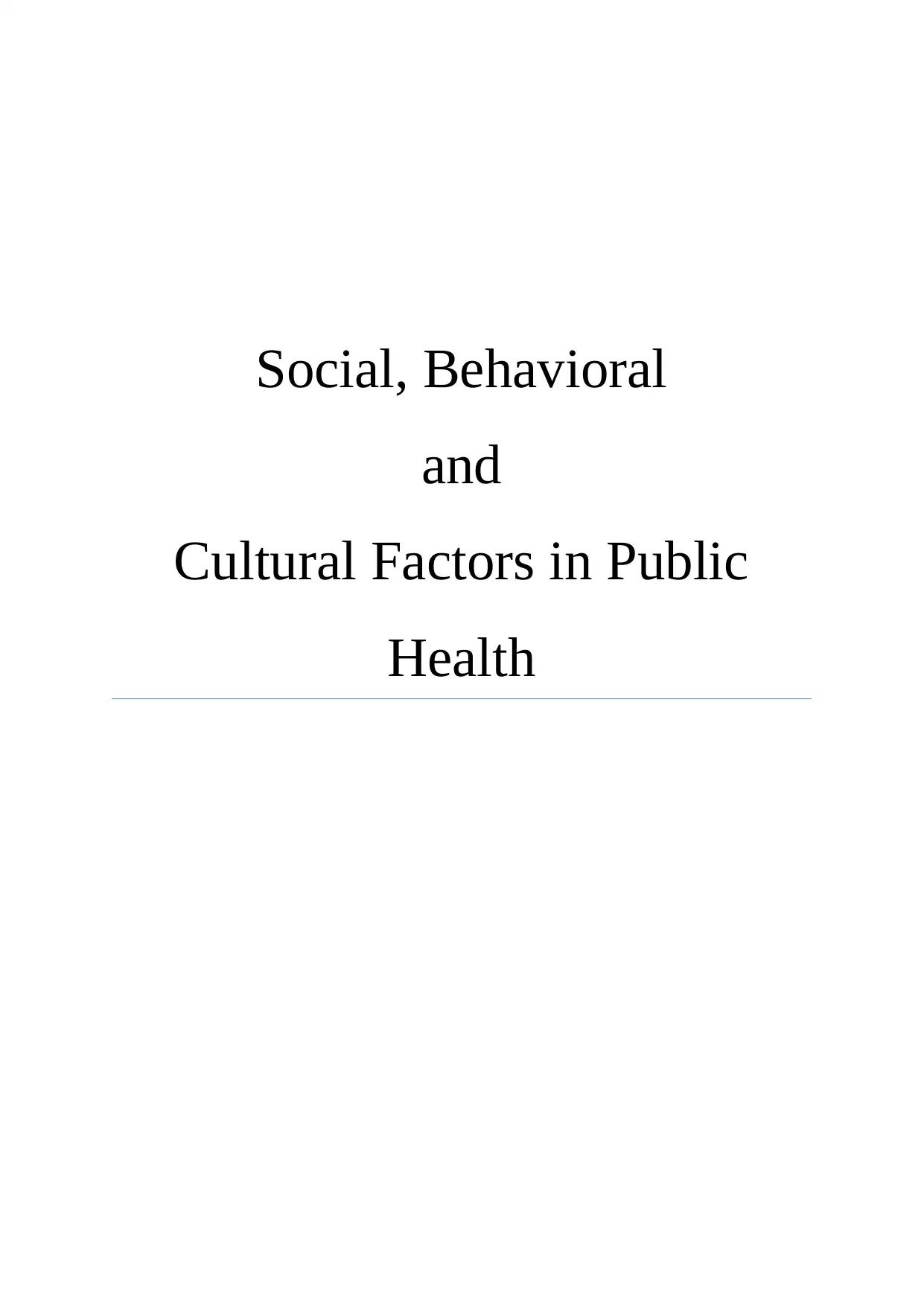
Social, Behavioral
and
Cultural Factors in Public
Health
and
Cultural Factors in Public
Health
Paraphrase This Document
Need a fresh take? Get an instant paraphrase of this document with our AI Paraphraser
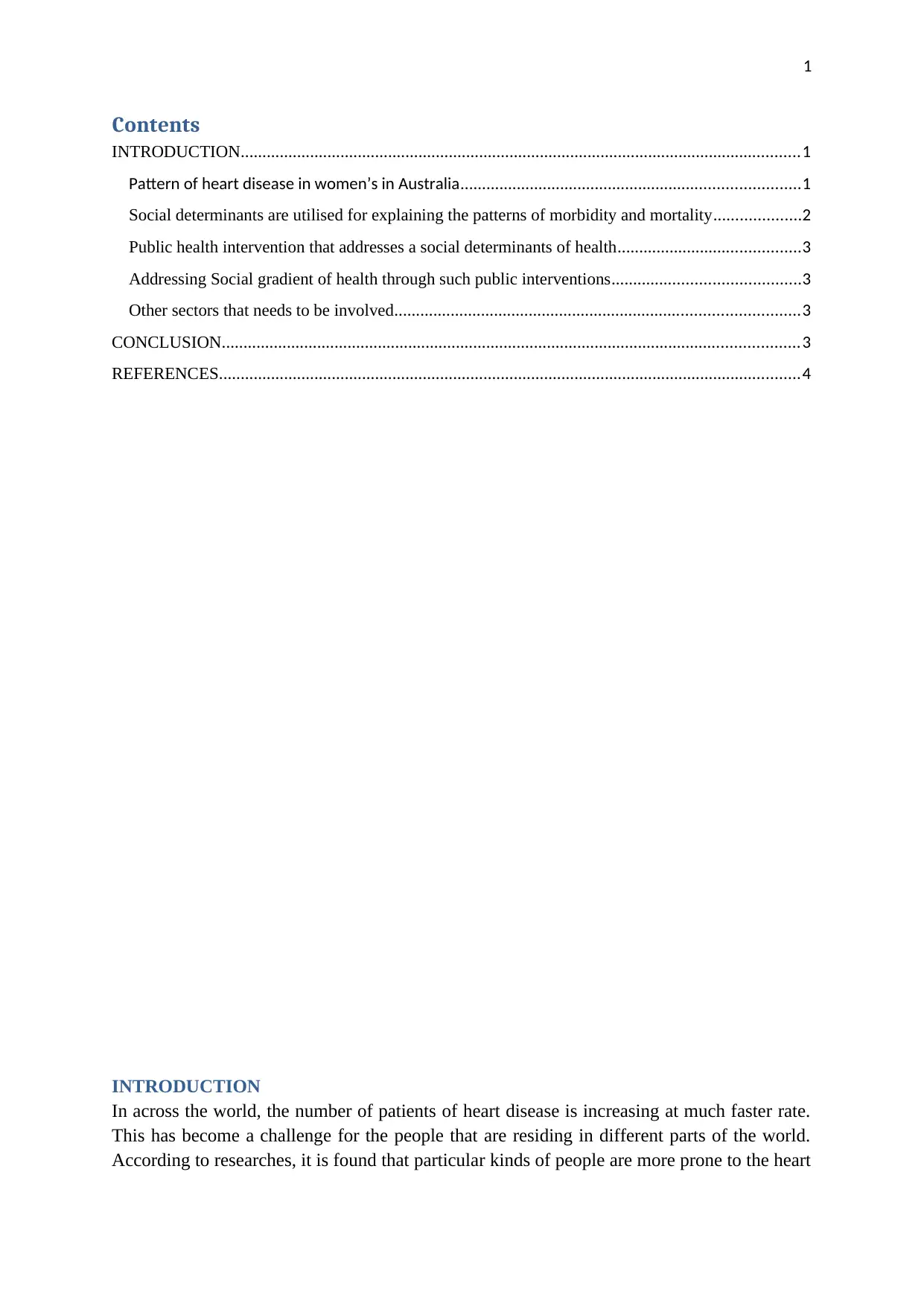
1
Contents
INTRODUCTION.................................................................................................................................1
Pattern of heart disease in women’s in Australia..............................................................................1
Social determinants are utilised for explaining the patterns of morbidity and mortality....................2
Public health intervention that addresses a social determinants of health..........................................3
Addressing Social gradient of health through such public interventions...........................................3
Other sectors that needs to be involved.............................................................................................3
CONCLUSION.....................................................................................................................................3
REFERENCES......................................................................................................................................4
INTRODUCTION
In across the world, the number of patients of heart disease is increasing at much faster rate.
This has become a challenge for the people that are residing in different parts of the world.
According to researches, it is found that particular kinds of people are more prone to the heart
Contents
INTRODUCTION.................................................................................................................................1
Pattern of heart disease in women’s in Australia..............................................................................1
Social determinants are utilised for explaining the patterns of morbidity and mortality....................2
Public health intervention that addresses a social determinants of health..........................................3
Addressing Social gradient of health through such public interventions...........................................3
Other sectors that needs to be involved.............................................................................................3
CONCLUSION.....................................................................................................................................3
REFERENCES......................................................................................................................................4
INTRODUCTION
In across the world, the number of patients of heart disease is increasing at much faster rate.
This has become a challenge for the people that are residing in different parts of the world.
According to researches, it is found that particular kinds of people are more prone to the heart
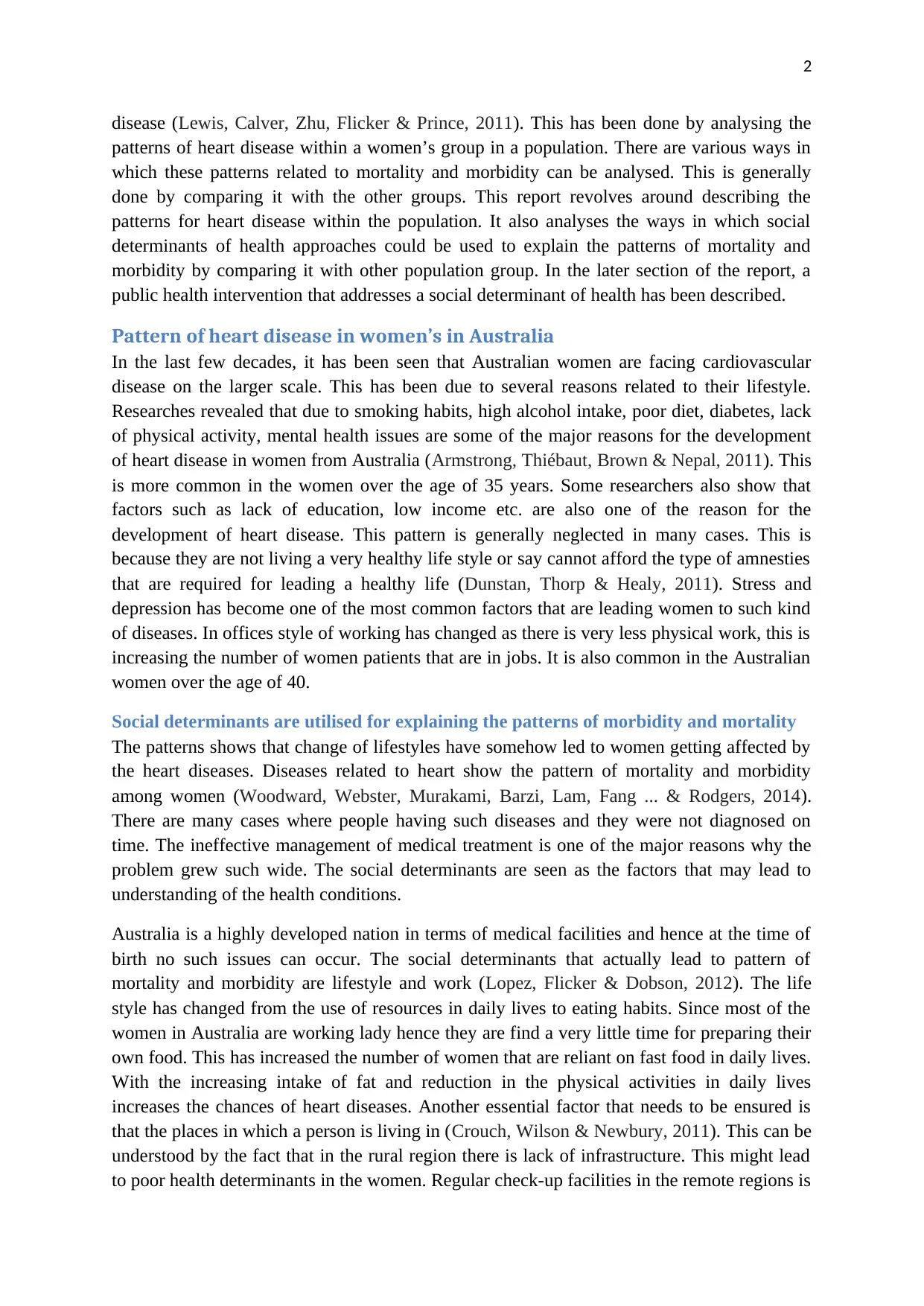
2
disease (Lewis, Calver, Zhu, Flicker & Prince, 2011). This has been done by analysing the
patterns of heart disease within a women’s group in a population. There are various ways in
which these patterns related to mortality and morbidity can be analysed. This is generally
done by comparing it with the other groups. This report revolves around describing the
patterns for heart disease within the population. It also analyses the ways in which social
determinants of health approaches could be used to explain the patterns of mortality and
morbidity by comparing it with other population group. In the later section of the report, a
public health intervention that addresses a social determinant of health has been described.
Pattern of heart disease in women’s in Australia
In the last few decades, it has been seen that Australian women are facing cardiovascular
disease on the larger scale. This has been due to several reasons related to their lifestyle.
Researches revealed that due to smoking habits, high alcohol intake, poor diet, diabetes, lack
of physical activity, mental health issues are some of the major reasons for the development
of heart disease in women from Australia (Armstrong, Thiébaut, Brown & Nepal, 2011). This
is more common in the women over the age of 35 years. Some researchers also show that
factors such as lack of education, low income etc. are also one of the reason for the
development of heart disease. This pattern is generally neglected in many cases. This is
because they are not living a very healthy life style or say cannot afford the type of amnesties
that are required for leading a healthy life (Dunstan, Thorp & Healy, 2011). Stress and
depression has become one of the most common factors that are leading women to such kind
of diseases. In offices style of working has changed as there is very less physical work, this is
increasing the number of women patients that are in jobs. It is also common in the Australian
women over the age of 40.
Social determinants are utilised for explaining the patterns of morbidity and mortality
The patterns shows that change of lifestyles have somehow led to women getting affected by
the heart diseases. Diseases related to heart show the pattern of mortality and morbidity
among women (Woodward, Webster, Murakami, Barzi, Lam, Fang ... & Rodgers, 2014).
There are many cases where people having such diseases and they were not diagnosed on
time. The ineffective management of medical treatment is one of the major reasons why the
problem grew such wide. The social determinants are seen as the factors that may lead to
understanding of the health conditions.
Australia is a highly developed nation in terms of medical facilities and hence at the time of
birth no such issues can occur. The social determinants that actually lead to pattern of
mortality and morbidity are lifestyle and work (Lopez, Flicker & Dobson, 2012). The life
style has changed from the use of resources in daily lives to eating habits. Since most of the
women in Australia are working lady hence they are find a very little time for preparing their
own food. This has increased the number of women that are reliant on fast food in daily lives.
With the increasing intake of fat and reduction in the physical activities in daily lives
increases the chances of heart diseases. Another essential factor that needs to be ensured is
that the places in which a person is living in (Crouch, Wilson & Newbury, 2011). This can be
understood by the fact that in the rural region there is lack of infrastructure. This might lead
to poor health determinants in the women. Regular check-up facilities in the remote regions is
disease (Lewis, Calver, Zhu, Flicker & Prince, 2011). This has been done by analysing the
patterns of heart disease within a women’s group in a population. There are various ways in
which these patterns related to mortality and morbidity can be analysed. This is generally
done by comparing it with the other groups. This report revolves around describing the
patterns for heart disease within the population. It also analyses the ways in which social
determinants of health approaches could be used to explain the patterns of mortality and
morbidity by comparing it with other population group. In the later section of the report, a
public health intervention that addresses a social determinant of health has been described.
Pattern of heart disease in women’s in Australia
In the last few decades, it has been seen that Australian women are facing cardiovascular
disease on the larger scale. This has been due to several reasons related to their lifestyle.
Researches revealed that due to smoking habits, high alcohol intake, poor diet, diabetes, lack
of physical activity, mental health issues are some of the major reasons for the development
of heart disease in women from Australia (Armstrong, Thiébaut, Brown & Nepal, 2011). This
is more common in the women over the age of 35 years. Some researchers also show that
factors such as lack of education, low income etc. are also one of the reason for the
development of heart disease. This pattern is generally neglected in many cases. This is
because they are not living a very healthy life style or say cannot afford the type of amnesties
that are required for leading a healthy life (Dunstan, Thorp & Healy, 2011). Stress and
depression has become one of the most common factors that are leading women to such kind
of diseases. In offices style of working has changed as there is very less physical work, this is
increasing the number of women patients that are in jobs. It is also common in the Australian
women over the age of 40.
Social determinants are utilised for explaining the patterns of morbidity and mortality
The patterns shows that change of lifestyles have somehow led to women getting affected by
the heart diseases. Diseases related to heart show the pattern of mortality and morbidity
among women (Woodward, Webster, Murakami, Barzi, Lam, Fang ... & Rodgers, 2014).
There are many cases where people having such diseases and they were not diagnosed on
time. The ineffective management of medical treatment is one of the major reasons why the
problem grew such wide. The social determinants are seen as the factors that may lead to
understanding of the health conditions.
Australia is a highly developed nation in terms of medical facilities and hence at the time of
birth no such issues can occur. The social determinants that actually lead to pattern of
mortality and morbidity are lifestyle and work (Lopez, Flicker & Dobson, 2012). The life
style has changed from the use of resources in daily lives to eating habits. Since most of the
women in Australia are working lady hence they are find a very little time for preparing their
own food. This has increased the number of women that are reliant on fast food in daily lives.
With the increasing intake of fat and reduction in the physical activities in daily lives
increases the chances of heart diseases. Another essential factor that needs to be ensured is
that the places in which a person is living in (Crouch, Wilson & Newbury, 2011). This can be
understood by the fact that in the rural region there is lack of infrastructure. This might lead
to poor health determinants in the women. Regular check-up facilities in the remote regions is
⊘ This is a preview!⊘
Do you want full access?
Subscribe today to unlock all pages.

Trusted by 1+ million students worldwide
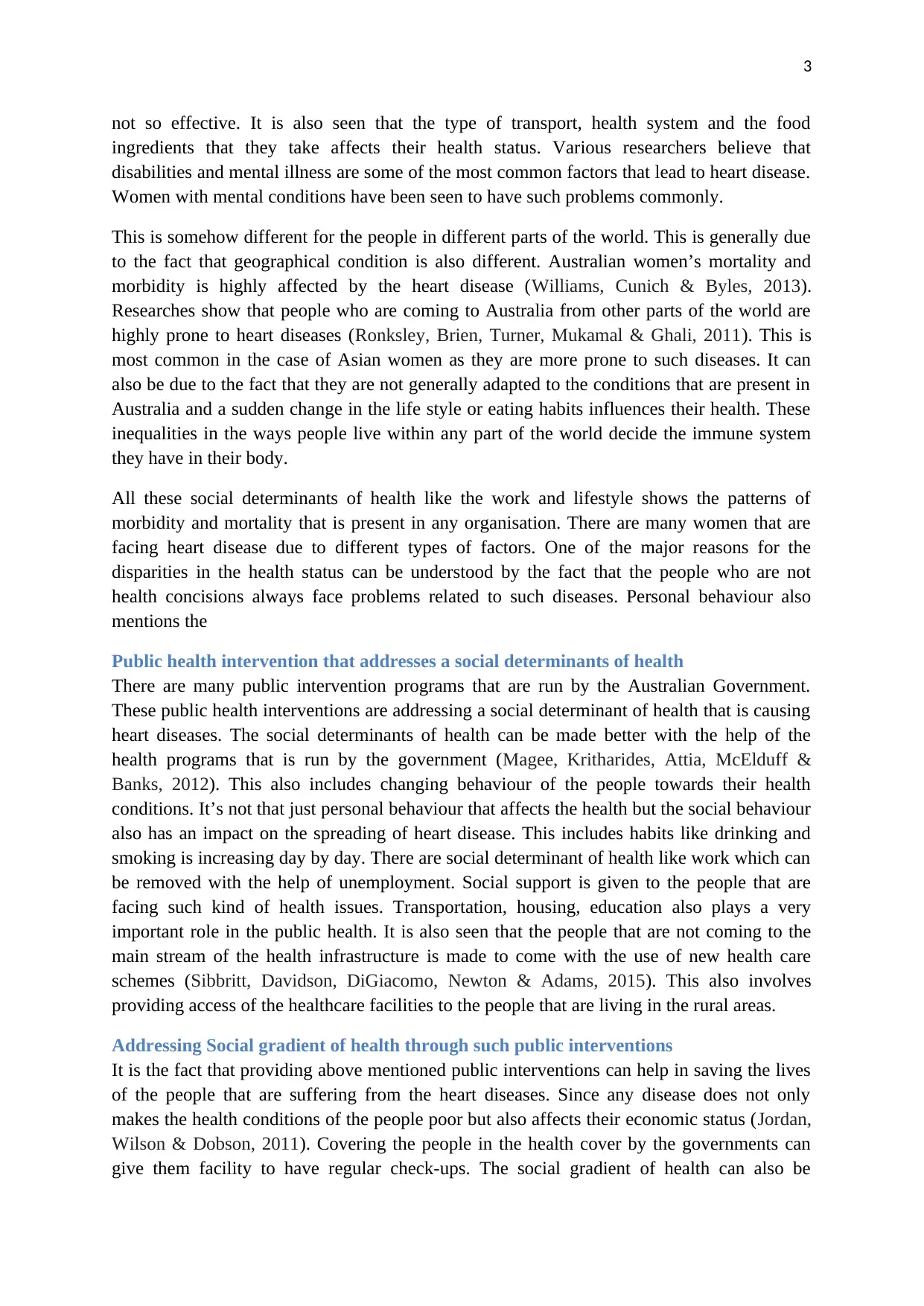
3
not so effective. It is also seen that the type of transport, health system and the food
ingredients that they take affects their health status. Various researchers believe that
disabilities and mental illness are some of the most common factors that lead to heart disease.
Women with mental conditions have been seen to have such problems commonly.
This is somehow different for the people in different parts of the world. This is generally due
to the fact that geographical condition is also different. Australian women’s mortality and
morbidity is highly affected by the heart disease (Williams, Cunich & Byles, 2013).
Researches show that people who are coming to Australia from other parts of the world are
highly prone to heart diseases (Ronksley, Brien, Turner, Mukamal & Ghali, 2011). This is
most common in the case of Asian women as they are more prone to such diseases. It can
also be due to the fact that they are not generally adapted to the conditions that are present in
Australia and a sudden change in the life style or eating habits influences their health. These
inequalities in the ways people live within any part of the world decide the immune system
they have in their body.
All these social determinants of health like the work and lifestyle shows the patterns of
morbidity and mortality that is present in any organisation. There are many women that are
facing heart disease due to different types of factors. One of the major reasons for the
disparities in the health status can be understood by the fact that the people who are not
health concisions always face problems related to such diseases. Personal behaviour also
mentions the
Public health intervention that addresses a social determinants of health
There are many public intervention programs that are run by the Australian Government.
These public health interventions are addressing a social determinant of health that is causing
heart diseases. The social determinants of health can be made better with the help of the
health programs that is run by the government (Magee, Kritharides, Attia, McElduff &
Banks, 2012). This also includes changing behaviour of the people towards their health
conditions. It’s not that just personal behaviour that affects the health but the social behaviour
also has an impact on the spreading of heart disease. This includes habits like drinking and
smoking is increasing day by day. There are social determinant of health like work which can
be removed with the help of unemployment. Social support is given to the people that are
facing such kind of health issues. Transportation, housing, education also plays a very
important role in the public health. It is also seen that the people that are not coming to the
main stream of the health infrastructure is made to come with the use of new health care
schemes (Sibbritt, Davidson, DiGiacomo, Newton & Adams, 2015). This also involves
providing access of the healthcare facilities to the people that are living in the rural areas.
Addressing Social gradient of health through such public interventions
It is the fact that providing above mentioned public interventions can help in saving the lives
of the people that are suffering from the heart diseases. Since any disease does not only
makes the health conditions of the people poor but also affects their economic status (Jordan,
Wilson & Dobson, 2011). Covering the people in the health cover by the governments can
give them facility to have regular check-ups. The social gradient of health can also be
not so effective. It is also seen that the type of transport, health system and the food
ingredients that they take affects their health status. Various researchers believe that
disabilities and mental illness are some of the most common factors that lead to heart disease.
Women with mental conditions have been seen to have such problems commonly.
This is somehow different for the people in different parts of the world. This is generally due
to the fact that geographical condition is also different. Australian women’s mortality and
morbidity is highly affected by the heart disease (Williams, Cunich & Byles, 2013).
Researches show that people who are coming to Australia from other parts of the world are
highly prone to heart diseases (Ronksley, Brien, Turner, Mukamal & Ghali, 2011). This is
most common in the case of Asian women as they are more prone to such diseases. It can
also be due to the fact that they are not generally adapted to the conditions that are present in
Australia and a sudden change in the life style or eating habits influences their health. These
inequalities in the ways people live within any part of the world decide the immune system
they have in their body.
All these social determinants of health like the work and lifestyle shows the patterns of
morbidity and mortality that is present in any organisation. There are many women that are
facing heart disease due to different types of factors. One of the major reasons for the
disparities in the health status can be understood by the fact that the people who are not
health concisions always face problems related to such diseases. Personal behaviour also
mentions the
Public health intervention that addresses a social determinants of health
There are many public intervention programs that are run by the Australian Government.
These public health interventions are addressing a social determinant of health that is causing
heart diseases. The social determinants of health can be made better with the help of the
health programs that is run by the government (Magee, Kritharides, Attia, McElduff &
Banks, 2012). This also includes changing behaviour of the people towards their health
conditions. It’s not that just personal behaviour that affects the health but the social behaviour
also has an impact on the spreading of heart disease. This includes habits like drinking and
smoking is increasing day by day. There are social determinant of health like work which can
be removed with the help of unemployment. Social support is given to the people that are
facing such kind of health issues. Transportation, housing, education also plays a very
important role in the public health. It is also seen that the people that are not coming to the
main stream of the health infrastructure is made to come with the use of new health care
schemes (Sibbritt, Davidson, DiGiacomo, Newton & Adams, 2015). This also involves
providing access of the healthcare facilities to the people that are living in the rural areas.
Addressing Social gradient of health through such public interventions
It is the fact that providing above mentioned public interventions can help in saving the lives
of the people that are suffering from the heart diseases. Since any disease does not only
makes the health conditions of the people poor but also affects their economic status (Jordan,
Wilson & Dobson, 2011). Covering the people in the health cover by the governments can
give them facility to have regular check-ups. The social gradient of health can also be
Paraphrase This Document
Need a fresh take? Get an instant paraphrase of this document with our AI Paraphraser
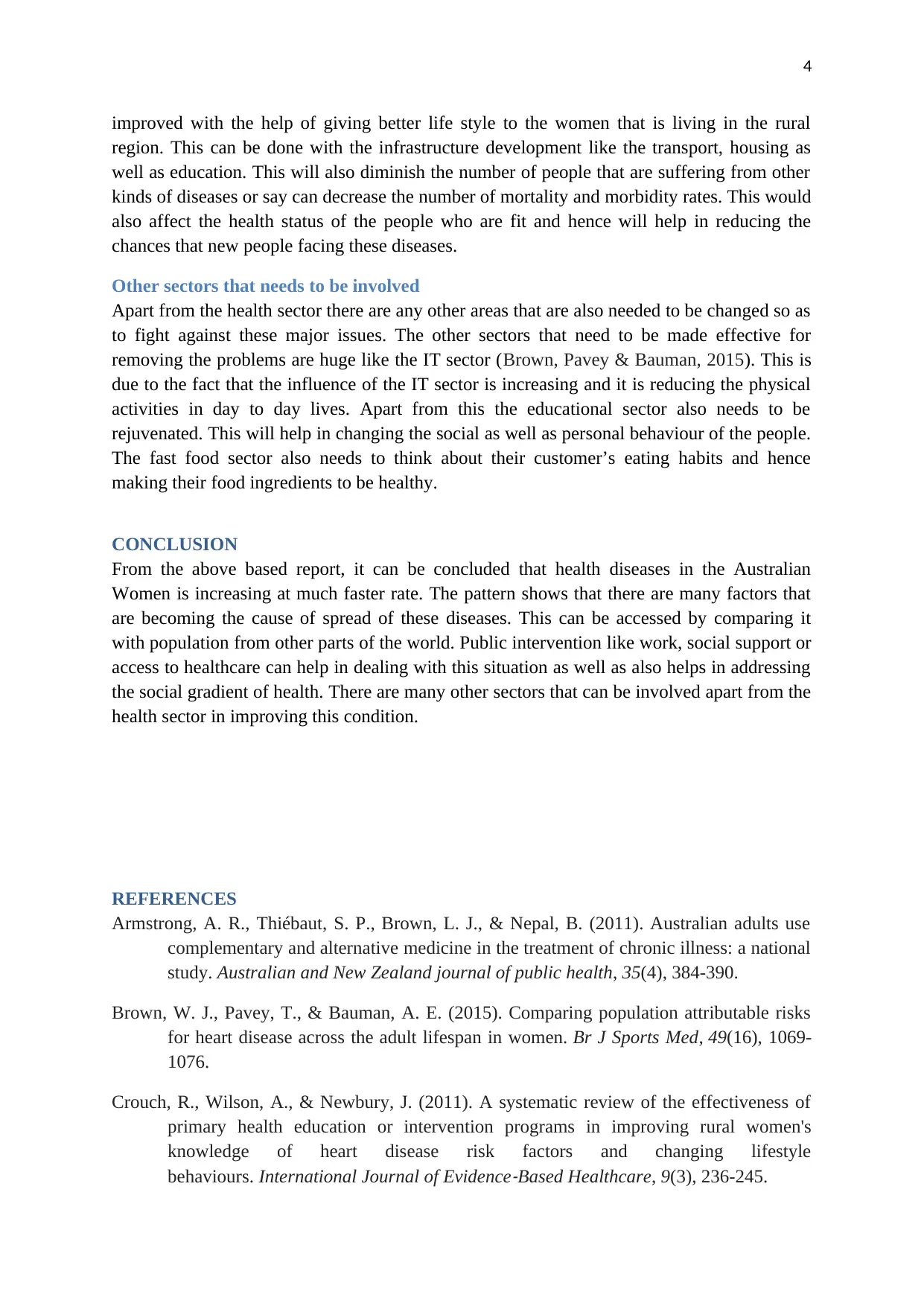
4
improved with the help of giving better life style to the women that is living in the rural
region. This can be done with the infrastructure development like the transport, housing as
well as education. This will also diminish the number of people that are suffering from other
kinds of diseases or say can decrease the number of mortality and morbidity rates. This would
also affect the health status of the people who are fit and hence will help in reducing the
chances that new people facing these diseases.
Other sectors that needs to be involved
Apart from the health sector there are any other areas that are also needed to be changed so as
to fight against these major issues. The other sectors that need to be made effective for
removing the problems are huge like the IT sector (Brown, Pavey & Bauman, 2015). This is
due to the fact that the influence of the IT sector is increasing and it is reducing the physical
activities in day to day lives. Apart from this the educational sector also needs to be
rejuvenated. This will help in changing the social as well as personal behaviour of the people.
The fast food sector also needs to think about their customer’s eating habits and hence
making their food ingredients to be healthy.
CONCLUSION
From the above based report, it can be concluded that health diseases in the Australian
Women is increasing at much faster rate. The pattern shows that there are many factors that
are becoming the cause of spread of these diseases. This can be accessed by comparing it
with population from other parts of the world. Public intervention like work, social support or
access to healthcare can help in dealing with this situation as well as also helps in addressing
the social gradient of health. There are many other sectors that can be involved apart from the
health sector in improving this condition.
REFERENCES
Armstrong, A. R., Thiébaut, S. P., Brown, L. J., & Nepal, B. (2011). Australian adults use
complementary and alternative medicine in the treatment of chronic illness: a national
study. Australian and New Zealand journal of public health, 35(4), 384-390.
Brown, W. J., Pavey, T., & Bauman, A. E. (2015). Comparing population attributable risks
for heart disease across the adult lifespan in women. Br J Sports Med, 49(16), 1069-
1076.
Crouch, R., Wilson, A., & Newbury, J. (2011). A systematic review of the effectiveness of
primary health education or intervention programs in improving rural women's
knowledge of heart disease risk factors and changing lifestyle
behaviours. International Journal of Evidence
‐Based Healthcare, 9(3), 236-245.
improved with the help of giving better life style to the women that is living in the rural
region. This can be done with the infrastructure development like the transport, housing as
well as education. This will also diminish the number of people that are suffering from other
kinds of diseases or say can decrease the number of mortality and morbidity rates. This would
also affect the health status of the people who are fit and hence will help in reducing the
chances that new people facing these diseases.
Other sectors that needs to be involved
Apart from the health sector there are any other areas that are also needed to be changed so as
to fight against these major issues. The other sectors that need to be made effective for
removing the problems are huge like the IT sector (Brown, Pavey & Bauman, 2015). This is
due to the fact that the influence of the IT sector is increasing and it is reducing the physical
activities in day to day lives. Apart from this the educational sector also needs to be
rejuvenated. This will help in changing the social as well as personal behaviour of the people.
The fast food sector also needs to think about their customer’s eating habits and hence
making their food ingredients to be healthy.
CONCLUSION
From the above based report, it can be concluded that health diseases in the Australian
Women is increasing at much faster rate. The pattern shows that there are many factors that
are becoming the cause of spread of these diseases. This can be accessed by comparing it
with population from other parts of the world. Public intervention like work, social support or
access to healthcare can help in dealing with this situation as well as also helps in addressing
the social gradient of health. There are many other sectors that can be involved apart from the
health sector in improving this condition.
REFERENCES
Armstrong, A. R., Thiébaut, S. P., Brown, L. J., & Nepal, B. (2011). Australian adults use
complementary and alternative medicine in the treatment of chronic illness: a national
study. Australian and New Zealand journal of public health, 35(4), 384-390.
Brown, W. J., Pavey, T., & Bauman, A. E. (2015). Comparing population attributable risks
for heart disease across the adult lifespan in women. Br J Sports Med, 49(16), 1069-
1076.
Crouch, R., Wilson, A., & Newbury, J. (2011). A systematic review of the effectiveness of
primary health education or intervention programs in improving rural women's
knowledge of heart disease risk factors and changing lifestyle
behaviours. International Journal of Evidence
‐Based Healthcare, 9(3), 236-245.
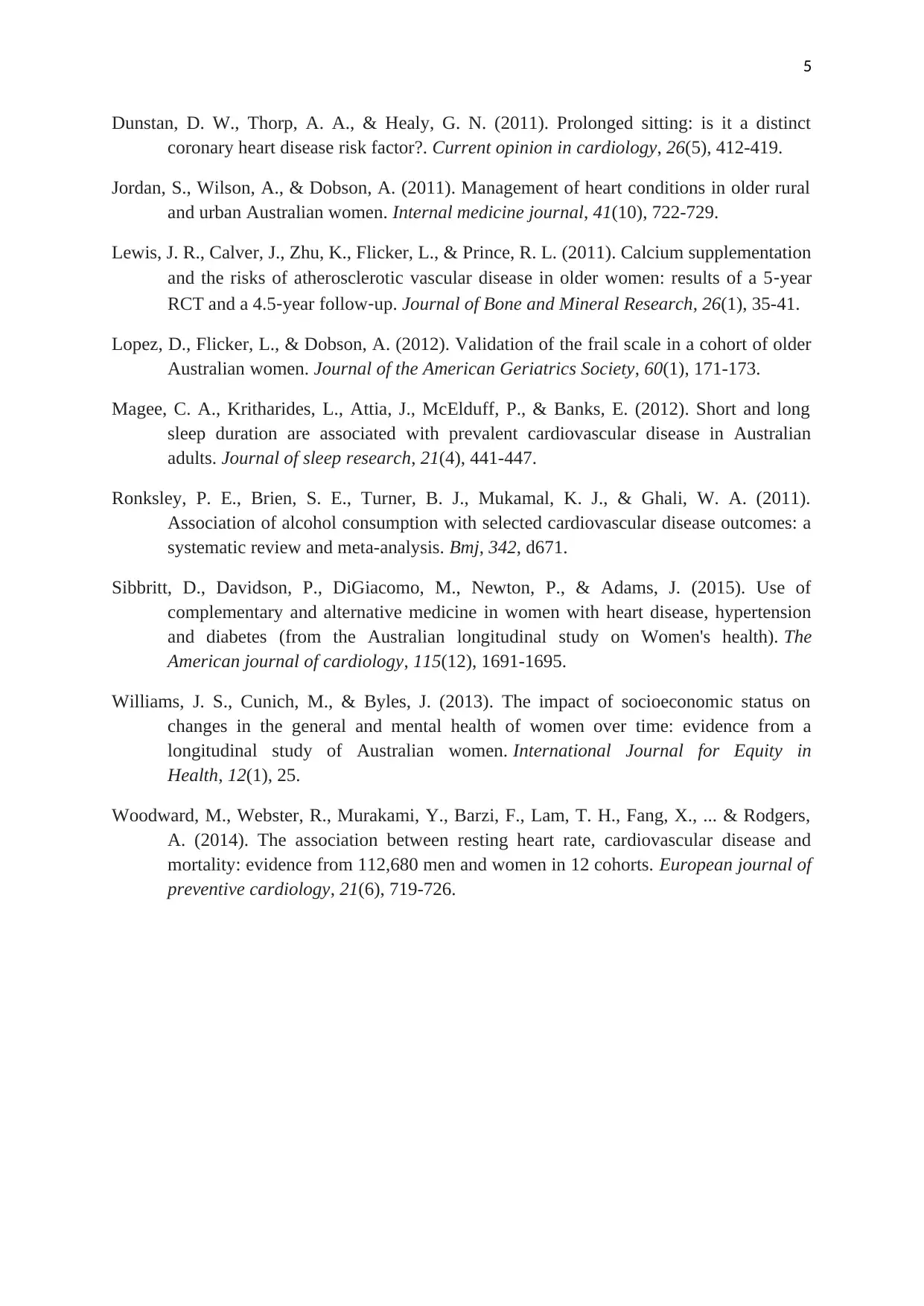
5
Dunstan, D. W., Thorp, A. A., & Healy, G. N. (2011). Prolonged sitting: is it a distinct
coronary heart disease risk factor?. Current opinion in cardiology, 26(5), 412-419.
Jordan, S., Wilson, A., & Dobson, A. (2011). Management of heart conditions in older rural
and urban Australian women. Internal medicine journal, 41(10), 722-729.
Lewis, J. R., Calver, J., Zhu, K., Flicker, L., & Prince, R. L. (2011). Calcium supplementation
and the risks of atherosclerotic vascular disease in older women: results of a 5‐year
RCT and a 4.5‐year follow‐up. Journal of Bone and Mineral Research, 26(1), 35-41.
Lopez, D., Flicker, L., & Dobson, A. (2012). Validation of the frail scale in a cohort of older
Australian women. Journal of the American Geriatrics Society, 60(1), 171-173.
Magee, C. A., Kritharides, L., Attia, J., McElduff, P., & Banks, E. (2012). Short and long
sleep duration are associated with prevalent cardiovascular disease in Australian
adults. Journal of sleep research, 21(4), 441-447.
Ronksley, P. E., Brien, S. E., Turner, B. J., Mukamal, K. J., & Ghali, W. A. (2011).
Association of alcohol consumption with selected cardiovascular disease outcomes: a
systematic review and meta-analysis. Bmj, 342, d671.
Sibbritt, D., Davidson, P., DiGiacomo, M., Newton, P., & Adams, J. (2015). Use of
complementary and alternative medicine in women with heart disease, hypertension
and diabetes (from the Australian longitudinal study on Women's health). The
American journal of cardiology, 115(12), 1691-1695.
Williams, J. S., Cunich, M., & Byles, J. (2013). The impact of socioeconomic status on
changes in the general and mental health of women over time: evidence from a
longitudinal study of Australian women. International Journal for Equity in
Health, 12(1), 25.
Woodward, M., Webster, R., Murakami, Y., Barzi, F., Lam, T. H., Fang, X., ... & Rodgers,
A. (2014). The association between resting heart rate, cardiovascular disease and
mortality: evidence from 112,680 men and women in 12 cohorts. European journal of
preventive cardiology, 21(6), 719-726.
Dunstan, D. W., Thorp, A. A., & Healy, G. N. (2011). Prolonged sitting: is it a distinct
coronary heart disease risk factor?. Current opinion in cardiology, 26(5), 412-419.
Jordan, S., Wilson, A., & Dobson, A. (2011). Management of heart conditions in older rural
and urban Australian women. Internal medicine journal, 41(10), 722-729.
Lewis, J. R., Calver, J., Zhu, K., Flicker, L., & Prince, R. L. (2011). Calcium supplementation
and the risks of atherosclerotic vascular disease in older women: results of a 5‐year
RCT and a 4.5‐year follow‐up. Journal of Bone and Mineral Research, 26(1), 35-41.
Lopez, D., Flicker, L., & Dobson, A. (2012). Validation of the frail scale in a cohort of older
Australian women. Journal of the American Geriatrics Society, 60(1), 171-173.
Magee, C. A., Kritharides, L., Attia, J., McElduff, P., & Banks, E. (2012). Short and long
sleep duration are associated with prevalent cardiovascular disease in Australian
adults. Journal of sleep research, 21(4), 441-447.
Ronksley, P. E., Brien, S. E., Turner, B. J., Mukamal, K. J., & Ghali, W. A. (2011).
Association of alcohol consumption with selected cardiovascular disease outcomes: a
systematic review and meta-analysis. Bmj, 342, d671.
Sibbritt, D., Davidson, P., DiGiacomo, M., Newton, P., & Adams, J. (2015). Use of
complementary and alternative medicine in women with heart disease, hypertension
and diabetes (from the Australian longitudinal study on Women's health). The
American journal of cardiology, 115(12), 1691-1695.
Williams, J. S., Cunich, M., & Byles, J. (2013). The impact of socioeconomic status on
changes in the general and mental health of women over time: evidence from a
longitudinal study of Australian women. International Journal for Equity in
Health, 12(1), 25.
Woodward, M., Webster, R., Murakami, Y., Barzi, F., Lam, T. H., Fang, X., ... & Rodgers,
A. (2014). The association between resting heart rate, cardiovascular disease and
mortality: evidence from 112,680 men and women in 12 cohorts. European journal of
preventive cardiology, 21(6), 719-726.
⊘ This is a preview!⊘
Do you want full access?
Subscribe today to unlock all pages.

Trusted by 1+ million students worldwide

6
1 out of 7
Related Documents
Your All-in-One AI-Powered Toolkit for Academic Success.
+13062052269
info@desklib.com
Available 24*7 on WhatsApp / Email
![[object Object]](/_next/static/media/star-bottom.7253800d.svg)
Unlock your academic potential
Copyright © 2020–2025 A2Z Services. All Rights Reserved. Developed and managed by ZUCOL.




